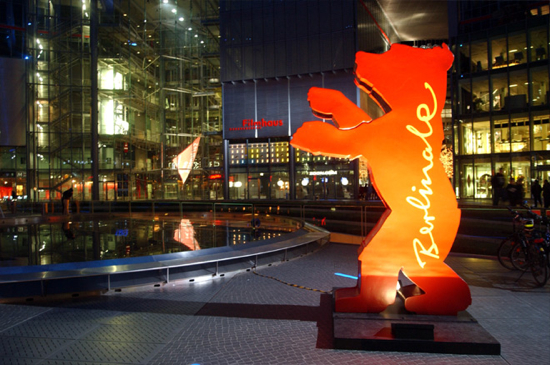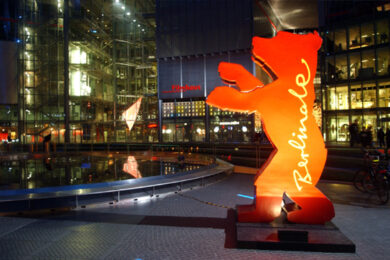There are no innocent buildings in Berlin. Every wall is stained with blood, every ruin a reminder of failed utopias, every gleaming new edifice haunted by echoes of past trauma. For most of the last century, the German capital was a laboratory for toxic social and political experiments, a gigantic sound stage for the longest disaster movie in history.
The opening weekend of the Berlinale film festival. Trudging though thick snow to a party in the Meistersaal, the largest room of the legendary Hansa studios: the hall where Bowie recorded "Heroes”, where Iggy made The Idiot and Lust For Life, where Depeche Mode and Nick Cave and Siouxsie and U2 and REM all stopped to soak up the Teutonic gravitas. With its mock-classical façade and granite-carved heaviness, this grand ballroom inevitably became a haunt for Nazi officers too, until their dreams of Germania crumbled and they retreated to Hitler’s bunker, barely two blocks away.
Since the millennium, the Berlinale has revolved around Potsdamer Platz, a fabled address with plenty of its own ghosts. A major commercial and social hub of pre-war Berlin, it was bombed to rubble during World War II, then became an abandoned wasteland for half a century as the Berlin Wall dividing capitalist West Germany and Communist East Germany sliced right across it. Since the Cold War ended, this former stretch of the Death Strip has blossomed again into a mini-Las Vegas of shopping malls, high-rise hotels, cinemas, museums and residential buildings. The architecture is a garish and jarring patchwork of styles, but the scale still impresses.
The festival’s main competition films all have gala screenings in the purpose-built Berlinale Palast, a graceless beached supertanker of sharp angles, jutting steel and thick glass. After a run of patchy programmes, this year sees a surprisingly strong field of mostly European dramas making their Palast debut, many by fresh talents. Women in war zones and monochrome colour palettes are recurring motifs. Most of these stories put you through the emotional shredder, then send you out reeling into the frosty Berlin air.
Films like the visually sumptuous Mercy, director Matthias Glasner’s powerful psycho-thriller about a German family plunged into a hellish crisis in Norway’s arctic north. Or Caesar Must Die by the veteran Italian brothers Paolo and Vittorio Taviani, a black-and-white docudrama staging Shakespeare’s Julius Ceaesar inside a real Roman prison, featuring a cast of genuine inmates and ex-cons. With Mike Leigh leading the Berlinale jury, it is perhaps no surprise that this jolting cold-water shower of old-school Euro-realism later wins the festival’s main award, the Golden Bear.
My personal choice for the big prize is War Witch by the Canadian director Kim Nguyen, a breathtaking ground-level view of African civil war seen through the eyes of a 12-year-old girl soldier. Harrowing but beautifully composed, with flashes of magical realism and ghosts woven into the action, the film’s teenage star Rachel Mwanza left Berlin with the festival’s Best Actress award. Although it was shot in the Democratic Republic of Congo, the terrific soundtrack mostly features vintage Afro-samba from the former Portuguese colony of Angola, warmly melodious grooves that stay with you even after the film ends.
Portugal’s imperial history in Africa features more heavily in another prize-winner, the sublime retro-romance Tabu, which begins as a gentle social comedy in modern-day Lisbon before flashing back 50 years to a torrid affair between a bored colonial wife and a dashing playboy drummer. Director Manuel Gomes weaves this absorbingly weird monochrome yarn with sound effects and music but no dialogue, creating a mesmerising fairy tale mood similar to The Artist. Full of playful touches, including the Ramones on the soundtrack, this achingly bittersweet reverie perfectly embodies the Portuguese notion of saudade – an unquenchable yearning for lost love, lost homeland, lost youth. Sigh.
Away from the Palast, the more prosaic daily business of the festival mostly takes place in the nearby Cinemaxx multiplex, a four-storey warren of screens that runs a round-the-clock schedule throughout the Berlinale. This was the unassuming venue for the European premiere of Angelina Jolie’s directing debut, the Balkan war drama In The Land Of Blood And Honey. Chronicling an agonised romance between a conflicted Serbian military commander and the Bosnian Muslim woman who later becomes his prisoner, this is a powerful piece of classic arthouse grimcore about ethnic cleansing and rape as a weapon of war. Not exactly an easy watch, but it speaks well of Jolie as both a serious filmmaker and humanitarian campaigner.
Another striking Cinemaxx premiere is James Marsh’s Shadow Dancer, which has parallels with Jolie’s film. Taking place in Belfast around the same time, 1993, this solid British-made thriller stars Andrea Riseborough as an IRA bomber and single mother blackmailed into becoming a double agent by Clive Owen’s British intelligence officer. Like Jolie’s similarly fatalistic war story, this dance of death soon becomes a fraught balancing act between romantic attraction and lethal betrayal.
Biographical documentaries also feature heavily in the Cinemaxx schedule, with great interest around Kevin MacDonald’s Marley. A solid portrait of the late reggae legend Bob Marley featuring a cast of colourful characters like Bunny Wailer and Lee ‘Scratch’ Perry, this two-hour rock-doc is a slick and professional affair, although it feels too much like an officially approved project to dig too deep into Marley’s conflicts and contradictions.
Another engaging but unrevealing bio-doc is All Divided Selves, Luke Fowler’s impressionistic film on the celebrated Glaswegian ‘anti-psychiatrist’ and counter-culture thinker R.D. Laing. Told in an Adam Curtis-style retro-montage of archive clips, Fowler’s film is artfully assembled but frustratingly low on factual detail. And likewise Klaartje Quirijns’ Anton Corbijn Inside Out, a handsome but slightly too reverential portrait of the iconic Dutch photographer and director featuring cameos by U2, Lou Reed, Metallica, George Clooney and more.
Just over the road from the Cinemaxx stands the Sony Center, one of post-Wall Berlin’s most divisive new buildings: a towering indoor/outdoor atrium topped with a vast flying saucer roof. This hulking cyberpunk monument to the final victory of corporate capitalism also contains a cluster of cinemas in its basement, a futuristic bunker that serves as the fitting launch venue for the demented Finnish sci-fi spoof Iron Sky.
One of the most hotly anticipated premieres of the Berlinale, Timo Vuorensola’s kitsch comedy thriller about a secret lunar colony of Nazis returning to invade Earth is a patchy mix of wooden performances, clunky jokes and camp costumes. But it does feature some fantastic special effects, a witty nod to the much-parodied Hitler biopic Downfall and a suitably bombastic cod-Wagnerian score by arch totalitarian art-rockers Laibach. Subtle as a Panzer division rolling towards Poland, sure, but slightly more fun.
The western edge of Potsdamer Platz is thronged by stately concert halls and art galleries that once loomed over the Berlin Wall, giant billboards for the cultural superiority of the capitalist system. But nowadays, ironically, Berlin’s true artistic centre of gravity lies a mile or two eastward, deep inside the old Communist zone. These are the grungy boho districts where artists, writers, musicians, film-makers and other cultural exiles from across the globe congregate, drawn by cheap rents and buzzing scenes.
The cinemas of old East Berlin that serve as satellite venues during the festival remain plush people’s palaces, monuments to the proletarian propaganda form that Lenin himself called "the most important art". But many have more exotic histories layered into their baroque brickwork. The Friedrichspalast, for example, is a cavernous 19th century music hall that was renamed and remodelled by the Nazis, who condemned its ornate ceiling décor as "degenerate art". Later, under Communist rule, it became am opulent venue for state-approved cabaret spectaculars, Soviet-style choirs and kitsch TV variety shows.
The Friedrichspalast is the perfect venue to see director Christian Petzold’s chilly thriller Barbara, another festival prize-winner, which takes place 30 years ago in the old DDR. Petzold’s regular collaborator Nina Hoss plays a doctor exiled from East Berlin to a Baltic backwater for the crime of applying to leave her Socialist paradise home. Like a more downbeat cousin of The Lives Of Others, this tense and absorbing character study weighs up the psychological cost of living in a surveillance state.
Deeper into the old Eastern Bloc, nestled in the voluptuous Art Deco curves of the Coliseum cinema, similar subject matter gets a very different treatment in This Ain’t California. Smartly blending old Super 8 home movies, newly shot footage and animation, director Marten Persiel’s moving personal documentary about the skateboarding scene in 1980s East Berlin revisits an era when a gang of delinquent teenage friends transformed a totalitarian capital full of drab concrete plazas into a gigantic skate park. Complete with a vintage punk and electro soundtrack, this prize-winning testament to lost youth deserves a global audience.
The vast brutalist citadel of Alexanderplatz, once Communist East Berlin’s showcase plaza, features heavily in This Ain’t California. It still feels jarringly alien even two decades after the Wall: a broad concrete tundra dominated by the futuristic spiked-mirrorball of the iconic TV tower, the space-age Cold War construction that remains Germany’s tallest building today. This former Soviet Death Star still exudes a kind of weaponised, malevolent beauty. But in its shadow lies one of the city’s most unashamedly gorgeous cinemas, the Kino International, a deluxe relic of early 1960s Soviet modernism.
Here, beneath ostentatiously outsized chandeliers and an elegant wave-form ceiling, Communist Party officials once toasted glitzy Eastern Bloc-buster premieres with sugary Russian champagne. But today the International is better known as a gay club and cult movie house. At the Berlinale, it hosts a late-night screening of Guy Maddin’s monochrome noir thriller Keyhole, which plunges Jason Patric and Isabella Rossellini into a fever dream of sex, death, ghosts and gallows humour. Cryptic but highly seductive, it confirms Maddin’s reputation as the Canadian David Lynch.
The closing weekend of the festival. Another party inside another haunted monument to the scars of history, this time the vast entrance hall of Tempelhof airport, three miles south of Postdamer Platz. This is the curtain-closing bash for the Teddy awards, the Berlinale’s gay film section. Peaches is rocking the microphone onstage, dressed in wacky robes made from breast-shaped globes that recall the sartorial excesses of Peter Gabriel in his Genesis pomp. The crowd is full of seven foot tall drag queens.
A 1920s city airport that was massively expanded by the Nazis, Tempelhof finally stopped all flights in 2008 following a lengthy political battle over its future – and its past. Beneath the dancing queens at the Teddy Awards lies a labyrinth of secret wartime tunnels and underground aircraft factories. Awash with unexploded bombs and booby traps, the lower levels remain flooded to this day. The ghosts of Berlin may be long dead, but they never quite leave the party.



